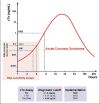High sensitivity troponins and conventional troponins at the bedside
- PMID: 25337489
- PMCID: PMC4200553
- DOI: 10.4103/2229-5151.141471
High sensitivity troponins and conventional troponins at the bedside
Abstract
The continuing advances in the biochemical research for the discovering an ideal biomarker for diagnosing myocardial injury have led to discovery cardiac Troponin, a biochemical gold standard for myocardial necrosis. Further with advances in the immunoassay techniques, the 99th percentile cutoff value of cardiac troponin required for the diagnosis of myocardial infarction decreased, with the latest available ultrasensitive cardiac troponin assay capable of measuring level as low as 0.005 ng/ml. Troponin have both diagnostic as well as prognostic significance in myocardial necrosis, but the cut off value by 99th percentile rule is useful only when applied to patients with a high pretest probability of Acute Coronary Syndrome(ACS) and also the results must be interpreted in the context of clinical history, ECG findings, and possibly cardiac imaging to establish the correct diagnosis. As cardiac troponins are also elevated in other cardiac conditions such as cardiomyopaties, the serial monitoring of the cardiac troponin level along with the absolute value would help to differentiate myocardial infarction from these many varied conditions, with the interval of serial assay being reduced to 3 hours. The aim of this review is to complement the advantages, to emphasize on proper interpretation of positive results, to appraise the challenges faced with the available cardiac troponin assays and need for further research to overcome them and build up the most ideal cardiac marker for diagnosing the myocardial infarction.
Keywords: Acute coronary syndrome; cardiac troponin; myocardial infarction.
Conflict of interest statement
Figures

Similar articles
-
High-sensitivity cardiac troponin assays: From improved analytical performance to enhanced risk stratification.Crit Rev Clin Lab Sci. 2017 May;54(3):143-172. doi: 10.1080/10408363.2017.1285268. Epub 2017 May 1. Crit Rev Clin Lab Sci. 2017. PMID: 28457177 Review.
-
Delta creatine kinase-MB outperforms myoglobin at two hours during the emergency department identification and exclusion of troponin positive non-ST-segment elevation acute coronary syndromes.Ann Emerg Med. 2004 Jul;44(1):12-9. doi: 10.1016/j.annemergmed.2004.02.003. Ann Emerg Med. 2004. PMID: 15226704 Clinical Trial.
-
Troponins in acute coronary syndromes.Semin Vasc Med. 2003 Nov;3(4):363-74. doi: 10.1055/s-2004-815694. Semin Vasc Med. 2003. PMID: 15199443 Review.
-
Decision limits and the reporting of cardiac troponin: Meeting the needs of both the cardiologist and the ED physician.Crit Rev Clin Lab Sci. 2015 Feb;52(1):28-44. doi: 10.3109/10408363.2014.972497. Epub 2014 Nov 14. Crit Rev Clin Lab Sci. 2015. PMID: 25397345
-
Troponins in acute coronary syndromes.Prog Cardiovasc Dis. 2004 Nov-Dec;47(3):177-88. doi: 10.1016/j.pcad.2004.07.004. Prog Cardiovasc Dis. 2004. PMID: 15736583 Review.
Cited by
-
The Impact of an Accelerated Diagnostic Protocol Using Conventional Troponin I for Patients With Cardiac Chest Pain in the Emergency Department.CJC Open. 2024 Mar 22;6(7):915-924. doi: 10.1016/j.cjco.2024.03.008. eCollection 2024 Jul. CJC Open. 2024. PMID: 39026624 Free PMC article.
-
Effect of a High-Sensitivity Troponin I and Associated Diagnostic Protocol on Emergency Department Length of Stay: A Retrospective Cohort Study.CJC Open. 2023 Sep 14;5(12):925-933. doi: 10.1016/j.cjco.2023.09.007. eCollection 2023 Dec. CJC Open. 2023. PMID: 38204856 Free PMC article.
-
Development of a New Detection Algorithm to Identify Acute Coronary Syndrome Using Electrochemical Biosensors for Real-World Long-Term Monitoring.Bioengineering (Basel). 2021 Feb 20;8(2):28. doi: 10.3390/bioengineering8020028. Bioengineering (Basel). 2021. PMID: 33672658 Free PMC article.
-
Effectiveness of accelerated diagnostic protocols for reducing emergency department length of stay in patients presenting with chest pain: A systematic review and meta-analysis.PLoS One. 2024 Oct 22;19(10):e0309767. doi: 10.1371/journal.pone.0309767. eCollection 2024. PLoS One. 2024. PMID: 39436875 Free PMC article.
-
Cardiological Society of India: Position statement for the management of ST elevation myocardial infarction in India.Indian Heart J. 2017 Apr;69 Suppl 1(Suppl 1):S63-S97. doi: 10.1016/j.ihj.2017.03.006. Epub 2017 Mar 23. Indian Heart J. 2017. PMID: 28400042 Free PMC article. Review. No abstract available.
References
-
- Rajappa M, Sharma A. Biomarkers of cardiac injury: An update. Angiol. 2005;56:677–91. - PubMed
-
- Filatov VL1, Katrukha AG, Bulargina TV, Gusev NB. Troponin: structure, properties, and mechanism of functioning. Biochemistry (Mosc) 1999 Sep;64:969–85. - PubMed
-
- Thygesen K, Alpert JS, White HD. Joint ESC/ACCF/AHA/WHF Task Force for the Redefinition of Myocardial Infarction. Universal definition of myocardial infarction. J Am Coll Cardiol. 2012;60:1581–98. - PubMed
-
- Melanson SE, Morrow DA, Jarolim P. Earlier detection of myocardial injury in a preliminary evaluation using a new troponin I assay with improved sensitivity. Am J Clin Pathol. 2007;128:282–6. - PubMed
-
- Melanson SE, Conrad MJ, Mosammaparast N, Jarolim P. Implementation of a highly sensitive cardiac troponin I assay: Test volumes, positivity rates and interpretation of results. Clin Chim Acta. 2008;395:57–61. - PubMed
LinkOut - more resources
Full Text Sources
Other Literature Sources
Research Materials

